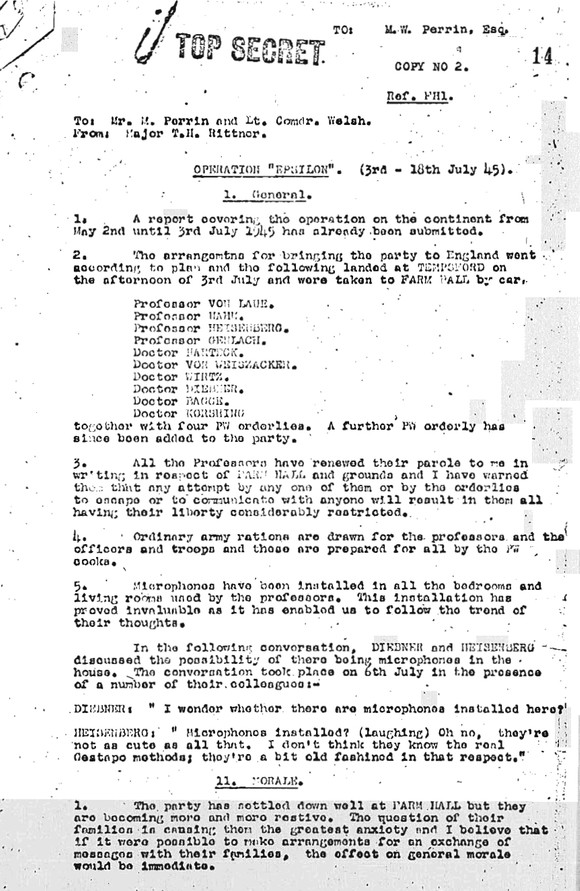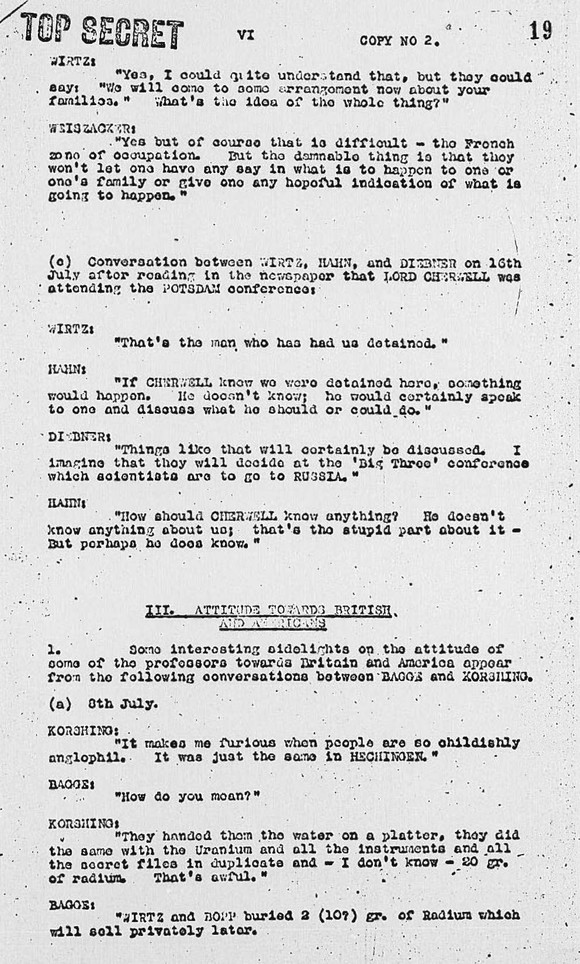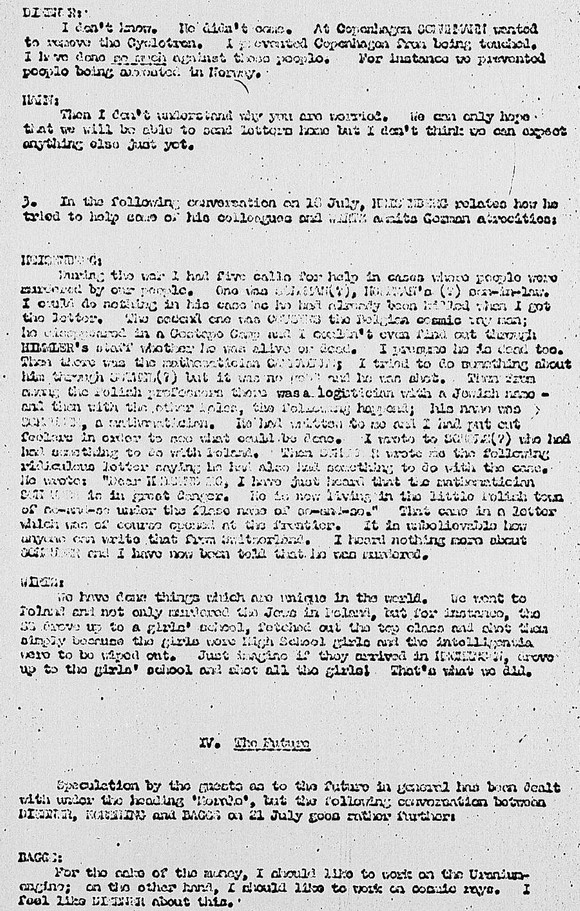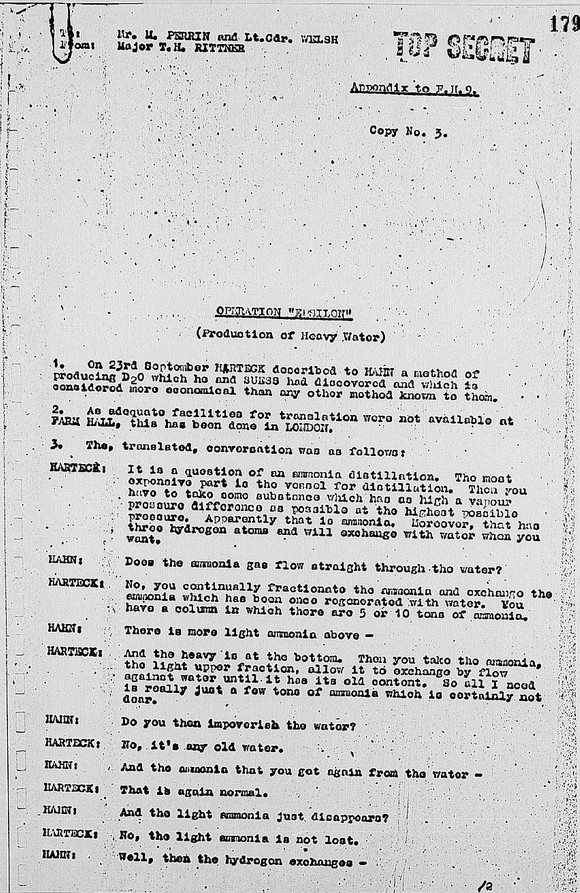Starting from:
$9.95
Home
Atomic - Nuclear
World War II: Operation EPSILON Detention of German Nuclear Scientists British Intelligence Files
World War II: Operation EPSILON Detention of German Nuclear Scientists British Intelligence Files
World War II: Operation EPSILON Detention of German Nuclear Scientists British Intelligence Files
225 pages of British War Office intelligence files, reports and transcripts, covering the detention and monitoring of German nuclear scientists, captured and detained at the end of the war with Germany.
The files contain approximately 125 discernible narrative pages.
Operation EPSILON was the code name given to the program under which ten top German scientists who it was believed to have been working in Germany's nuclear program, were captured between May 1 and June 30, 1945, and were eventually detained at an estate, Farm Hall, in Godmanchester, England, near Cambridge. The main objective of the operation was to learn what if any work was performed by Germany toward building an atomic bomb, and any possible achievements that resulted. They were held at Farm Hall from July 3, 1945 to January 3, 1946.
From transcript, July 6, 1945 at Farm Hall:
Kurt Diebner, German nuclear physicist: "I wonder whether there are microphones installed here?"
Werner Heisenberg, German theoretical physicist: "Microphones installed? (laughing) Oh no, they're not as cute as all that. I don't think they know the real Gestapo methods; they're a bit old fashioned in that respect."
The accurate answer would have been "yes." The primary goal of Operation EPSILON was to determine how close Nazi Germany had been to constructing an atomic bomb. The primary means enacted to do so was listening to the conversations between the scientists. Farm Hall was well bugged with listening device throughout the mansion.
The importance of these transcripts to history is that they do not convey information on the record made to allied interrogators; instead the scientists’ views and comments were made off the record to colleagues.
The files are reports that were kept TOP SECRET for 47 years, sent from the administrator of the operation, British military officer Major T.H. Rittner, to Lieutenant Commander Eric Welsh, a naval intelligence officer, and to Sir Michael Willcox Perrin, a scientist who directed the first British atomic bomb programme, and was charged with understanding the status of the German atomic program through the military intelligence services and their spy network.
The files contain reports on the gathering of the scientists and their funneling to Farm Hall. Contains briefs about the details of the creation and administration of the operation. The bulk of the material are reports published at regular intervals, on the activities at Farm Hall, along with translated highlights from the transcripts of conversations between the scientists, known as the Operation Epsilon Farm Hall Transcripts.
The transcripts of the recordings reveal both the primitive nature of Nazi Germany’s nuclear program and the personalities of those who worked on it.
In reviewing the transcripts, Northwestern University professor Irving M. Klotz found that the view that German scientists refrained from developing the atomic bomb for Nazi Germany for moral reasons was unfounded. This conclusion was expressed in Klotz's book, "Captives of Their Fantasies: The German Atomic Bomb Scientists."
The ten German scientists, often referred to as Hitler's Uranium Club, who were captured and detained at Farm Hall under Operation EPSILON, were:
Erich Bagge, who developed a gaseous uranium enrichment device for enriching the U-235 isotope content of uranium in 1944. Major Rittner described him as a serious and very hardworking young man. "He is completely German and unlikely to co-operate. His friendship with Diebner lays him open to suspicion."
Kurt Diebner, a German nuclear physicist who directed and administered the German nuclear energy project. He was director of the Nuclear Research Council and a Reich Planning Officer for the German Army until the collapse of Germany during World War II. Rittner described him as outwardly very friendly, "but has an un-pleasant personality and is not to be trusted. He is disliked by all the others except Bagge."
Walther Gerlach was a German physicist who co-discovered spin quantization in a magnetic field, known as the Stern-Gerlach effect. "Has a very cheerful disposition and is easy to handle. He appears to be genuinely co-operative," wrote Rittner.
Otto Hahn, a German chemist and Nobel laureate, his pioneering work in the fields of radioactivity and radiochemistry lead to him to being called "the father of nuclear chemistry". On November 15, 1945, while still under detention at Farm Hall, he was awarded the Nobel Prize in Chemistry, "for his discovery of the fission of heavy atomic nuclei." He also seems to have won some measure of revere from Major Rittner who referred to him in a report as, "A man of the world. He has been the most helpful of the professors and his sense of humor and common sense has saved the day on many occasions. He is definitely friendly disposed to England and America."
Paul Harteck, a German physical chemist, in 1939 contacted the Reichskriegsministerium (RKM, Reich Ministry of War) to alert them to the potential of military applications of nuclear chain reactions. Rittner's summary of Harteck, "A charming personality and has never caused any trouble. His one wish is to get on with his work. As he is a bachelor, he is less worried than the others about conditions in Germany."
Werner Heisenberg, a German theoretical physicist, he was one of the key creators of quantum mechanics. Heisenberg was awarded the Nobel Prize in Physics in 1932 "for the creation of quantum mechanics, the application of which has, inter alia, led to the discovery of the allotropic forms of hydrogen". Rittner's description of Heisenberg included a caveat, "He has been very friendly and helpful and is, I believe, genuinely anxious to co-operate with British and American scientists, although he has spoken of going over to the Russians".
Horst Korsching, a German physicist worked on isotope separation under Kurt Diebner and Werner Heisenberg. "A complete enigma," wrote Rittner, "He appears to be morose and surly. He very rarely opens his mouth. He has, however, become more human since his arrival in England."
Max von Laue, a German physicist who won the Nobel Prize in Physics in 1914 for his discovery of the diffraction of X-rays by crystals. His opposition to National Socialism distanced him from the other German scientists. Rittner characterized him as a, "shy mild mannered man. He cannot understand the reason for his detention. He has been very friendly and is very well disposed to England and America."
Carl Friedrich von Weizsäcker, a German physicist and philosopher, is known for theories regarding energy production in stars from nuclear fusion processes. Rittner described him as a diplomat. "He was always been very friendly and co-operative and I believe he is genuinely prepared to work with England and America but he is a good German."
Karl Wirtz, a German nuclear physicist, in 1940 joined the atomic research team led by Werner Heisenberg. "An egoist" wrote Rittner. "Very friendly on the surface but cannot be trusted. I doubt whether he will co-operate unless it is made worth his while."
A highlight among the material is the recorded reaction to the news of the first use of an atomic bomb at Hiroshima on August 6, 1945. All the scientists at Farm Hall expressed surprise or shock at the news of Hiroshima. Some doubted that it was true. Ensuing conversations expressed that Heisenberg, had either overestimated the amount of enriched uranium that an atomic bomb would require or consciously overstated it. The scientists muddled over how the American bomb was made and why Germany was not successful at producing an atomic device. Some of the scientists indicated that they were happy that they failed to be first at creating a nuclear bomb, that their failure denied making a nuclear bomb available for use by Adolf Hitler.




225 pages of British War Office intelligence files, reports and transcripts, covering the detention and monitoring of German nuclear scientists, captured and detained at the end of the war with Germany.
The files contain approximately 125 discernible narrative pages.
Operation EPSILON was the code name given to the program under which ten top German scientists who it was believed to have been working in Germany's nuclear program, were captured between May 1 and June 30, 1945, and were eventually detained at an estate, Farm Hall, in Godmanchester, England, near Cambridge. The main objective of the operation was to learn what if any work was performed by Germany toward building an atomic bomb, and any possible achievements that resulted. They were held at Farm Hall from July 3, 1945 to January 3, 1946.
From transcript, July 6, 1945 at Farm Hall:
Kurt Diebner, German nuclear physicist: "I wonder whether there are microphones installed here?"
Werner Heisenberg, German theoretical physicist: "Microphones installed? (laughing) Oh no, they're not as cute as all that. I don't think they know the real Gestapo methods; they're a bit old fashioned in that respect."
The accurate answer would have been "yes." The primary goal of Operation EPSILON was to determine how close Nazi Germany had been to constructing an atomic bomb. The primary means enacted to do so was listening to the conversations between the scientists. Farm Hall was well bugged with listening device throughout the mansion.
The importance of these transcripts to history is that they do not convey information on the record made to allied interrogators; instead the scientists’ views and comments were made off the record to colleagues.
The files are reports that were kept TOP SECRET for 47 years, sent from the administrator of the operation, British military officer Major T.H. Rittner, to Lieutenant Commander Eric Welsh, a naval intelligence officer, and to Sir Michael Willcox Perrin, a scientist who directed the first British atomic bomb programme, and was charged with understanding the status of the German atomic program through the military intelligence services and their spy network.
The files contain reports on the gathering of the scientists and their funneling to Farm Hall. Contains briefs about the details of the creation and administration of the operation. The bulk of the material are reports published at regular intervals, on the activities at Farm Hall, along with translated highlights from the transcripts of conversations between the scientists, known as the Operation Epsilon Farm Hall Transcripts.
The transcripts of the recordings reveal both the primitive nature of Nazi Germany’s nuclear program and the personalities of those who worked on it.
In reviewing the transcripts, Northwestern University professor Irving M. Klotz found that the view that German scientists refrained from developing the atomic bomb for Nazi Germany for moral reasons was unfounded. This conclusion was expressed in Klotz's book, "Captives of Their Fantasies: The German Atomic Bomb Scientists."
The ten German scientists, often referred to as Hitler's Uranium Club, who were captured and detained at Farm Hall under Operation EPSILON, were:
Erich Bagge, who developed a gaseous uranium enrichment device for enriching the U-235 isotope content of uranium in 1944. Major Rittner described him as a serious and very hardworking young man. "He is completely German and unlikely to co-operate. His friendship with Diebner lays him open to suspicion."
Kurt Diebner, a German nuclear physicist who directed and administered the German nuclear energy project. He was director of the Nuclear Research Council and a Reich Planning Officer for the German Army until the collapse of Germany during World War II. Rittner described him as outwardly very friendly, "but has an un-pleasant personality and is not to be trusted. He is disliked by all the others except Bagge."
Walther Gerlach was a German physicist who co-discovered spin quantization in a magnetic field, known as the Stern-Gerlach effect. "Has a very cheerful disposition and is easy to handle. He appears to be genuinely co-operative," wrote Rittner.
Otto Hahn, a German chemist and Nobel laureate, his pioneering work in the fields of radioactivity and radiochemistry lead to him to being called "the father of nuclear chemistry". On November 15, 1945, while still under detention at Farm Hall, he was awarded the Nobel Prize in Chemistry, "for his discovery of the fission of heavy atomic nuclei." He also seems to have won some measure of revere from Major Rittner who referred to him in a report as, "A man of the world. He has been the most helpful of the professors and his sense of humor and common sense has saved the day on many occasions. He is definitely friendly disposed to England and America."
Paul Harteck, a German physical chemist, in 1939 contacted the Reichskriegsministerium (RKM, Reich Ministry of War) to alert them to the potential of military applications of nuclear chain reactions. Rittner's summary of Harteck, "A charming personality and has never caused any trouble. His one wish is to get on with his work. As he is a bachelor, he is less worried than the others about conditions in Germany."
Werner Heisenberg, a German theoretical physicist, he was one of the key creators of quantum mechanics. Heisenberg was awarded the Nobel Prize in Physics in 1932 "for the creation of quantum mechanics, the application of which has, inter alia, led to the discovery of the allotropic forms of hydrogen". Rittner's description of Heisenberg included a caveat, "He has been very friendly and helpful and is, I believe, genuinely anxious to co-operate with British and American scientists, although he has spoken of going over to the Russians".
Horst Korsching, a German physicist worked on isotope separation under Kurt Diebner and Werner Heisenberg. "A complete enigma," wrote Rittner, "He appears to be morose and surly. He very rarely opens his mouth. He has, however, become more human since his arrival in England."
Max von Laue, a German physicist who won the Nobel Prize in Physics in 1914 for his discovery of the diffraction of X-rays by crystals. His opposition to National Socialism distanced him from the other German scientists. Rittner characterized him as a, "shy mild mannered man. He cannot understand the reason for his detention. He has been very friendly and is very well disposed to England and America."
Carl Friedrich von Weizsäcker, a German physicist and philosopher, is known for theories regarding energy production in stars from nuclear fusion processes. Rittner described him as a diplomat. "He was always been very friendly and co-operative and I believe he is genuinely prepared to work with England and America but he is a good German."
Karl Wirtz, a German nuclear physicist, in 1940 joined the atomic research team led by Werner Heisenberg. "An egoist" wrote Rittner. "Very friendly on the surface but cannot be trusted. I doubt whether he will co-operate unless it is made worth his while."
A highlight among the material is the recorded reaction to the news of the first use of an atomic bomb at Hiroshima on August 6, 1945. All the scientists at Farm Hall expressed surprise or shock at the news of Hiroshima. Some doubted that it was true. Ensuing conversations expressed that Heisenberg, had either overestimated the amount of enriched uranium that an atomic bomb would require or consciously overstated it. The scientists muddled over how the American bomb was made and why Germany was not successful at producing an atomic device. Some of the scientists indicated that they were happy that they failed to be first at creating a nuclear bomb, that their failure denied making a nuclear bomb available for use by Adolf Hitler.




1 file (75.2MB)



